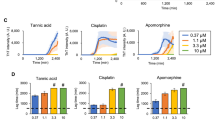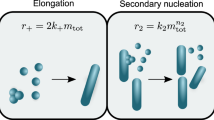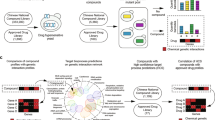Abstract
We have developed a rapid, yeast-based, two-step assay to screen for antiprion drugs. The method allowed us to identify several compounds effective against budding yeast prions responsible for the [PSI+] and [URE3] phenotypes. These inhibitors include the kastellpaolitines, a new class of compounds, and two previously known molecules, phenanthridine and 6-aminophenanthridine. Two potent promoters of mammalian prion clearance in vitro, quinacrine and chlorpromazine, which share structural similarities with the kastellpaolitines, were also active in the assay. The compounds isolated here were also active in promoting mammalian prion clearance. These results validate the present method as an efficient high-throughput screening approach to identify new prion inhibitors and furthermore suggest that biochemical pathways controlling prion formation and/or maintenance are conserved from yeast to humans.
This is a preview of subscription content, access via your institution
Access options
Subscribe to this journal
Receive 12 print issues and online access
$209.00 per year
only $17.42 per issue
Buy this article
- Purchase on Springer Link
- Instant access to full article PDF
Prices may be subject to local taxes which are calculated during checkout





Similar content being viewed by others
References
Prusiner, S.B. Novel proteinaceous infectious particles cause scrapie. Science 216, 136–144 (1982).
Aguzzi, A., Glatzel, M., Montrasio, F., Prinz, M. & Heppner, F.L. Interventional strategies against prion diseases. Nat. Rev. Neurosci. 2, 745–749 (2001).
Wille, H. et al. Structural studies of the scrapie prion protein by electron crystallography. Proc. Natl. Acad. Sci. USA 99, 3563–3568 (2002).
Cohen, F.E. et al. Structural clues to prion replication. Science 264, 530–531 (1994).
Korth, C., May, B.C., Cohen, F.E. & Prusiner, S.B. Acridine and phenothiazine derivatives as pharmacotherapeutics for prion disease. Proc. Natl. Acad. Sci. USA 98, 9836–9841 (2001).
Wickner, R.B., Edskes, H.K., Roberts, B.T., Pierce, M. & Baxa, U. Prions of yeast as epigenetic phenomena: high protein “copy number” inducing protein “silencing”. Adv. Genet. 46, 485–525 (2002).
Cox, B.S. Psi, a cytoplasmic supressor of super-supressor in yeast. Heredity 20, 505–521 (1965).
Lacroute, F. Non-Mendelian mutation allowing ureidosuccinic acid uptake in yeast. J. Bacteriol. 106, 519–522 (1971).
Wickner, R.B. [URE3] as an altered Ure2 protein: evidence for a prion analog in Saccharomyces cerevisiae. Science 264, 566–569 (1994).
Serio, T.R. & Lindquist, S.L. [PSI+], SUP35, and chaperones. Adv. Protein Chem. 57, 335–366 (2001).
Couzin, J. Molecular biology. In yeast, prions' killer image doesn't apply. Science 297, 758–761 (2002).
True, H.L. & Lindquist, S.L. A yeast prion provides a mechanism for genetic variation and phenotypic diversity. Nature 407, 477–483 (2000).
Wegrzyn, R.D., Bapat, K., Newnam, G.P., Zink, A.D. & Chernoff, Y.O. Mechanism of prion loss after Hsp104 inactivation in yeast. Mol. Cell. Biol. 21, 4656–4669 (2001).
Eaglestone, S.S., Ruddock, L.W., Cox, B.S. & Tuite, M.F. Guanidine hydrochloride blocks a critical step in the propagation of the prion-like determinant [PSI(+)] of Saccharomyces cerevisiae. Proc. Natl. Acad. Sci. USA 97, 240–244 (2000).
Ferreira, P.C., Ness, F., Edwards, S.R., Cox, B.S. & Tuite, M.F. The elimination of the yeast [PSI+] prion by guanidine hydrochloride is the result of Hsp104 inactivation. Mol. Microbiol. 40, 1357–1369 (2001).
Jung, G. & Masison, D.C. Guanidine hydrochloride inhibits Hsp104 activity in vivo: a possible explanation for its effect in curing yeast prions. Curr. Microbiol. 43, 7–10 (2001).
Chernoff, Y.O., Lindquist, S.L., Ono, B., Inge-Vechtomov, S.G. & Liebman, S.W. Role of the chaperone protein Hsp104 in propagation of the yeast prion-like factor [psi+]. Science 268, 880–884 (1995).
Nishida, N. et al. Successful transmission of three mouse-adapted scrapie strains to murine neuroblastoma cell lines overexpressing wild-type mouse prion protein. J. Virol. 74, 320–325 (2000).
Blondel, M. et al. Nuclear-specific degradation of Far1 is controlled by the localization of the F-box protein Cdc4. EMBO J. 19, 6085–6097 (2000).
Tuite, M.F., Mundy, C.R. & Cox, B.S. Agents that cause a high frequency of genetic change from [psi+] to [psi-] in Saccharomyces cerevisiae. Genetics 98, 691–711 (1981).
Jones, G.W., Song, Y. & Masison, D.C. Deletion of the Hsp70 chaperone gene SSB causes hypersensitivity to guanidine toxicity and curing of the [PSI(+)] prion by increasing guanidine uptake in yeast. Mol. Genet. Genomics 269, 304–311 (2003).
Schlumpberger, M., Prusiner, S.B. & Herskowitz, I. Induction of distinct [URE3] yeast prion strains. Mol. Cell. Biol. 21, 7035–7046 (2001).
Fernandez-Bellot, E., Guillemet, E. & Cullin, C. The yeast prion [URE3] can be greatly induced by a functional mutated URE2 allele. EMBO J. 19, 3215–3222 (2000).
Fernandez-Bellot, E. et al. The [URE3] phenotype: evidence for a soluble prion in yeast. EMBO Rep. 3, 76–81 (2002).
Zamora, J.M., Pearce, H.L. & Beck, W.T. Physical-chemical properties shared by compounds that modulate multidrug resistance in human leukemic cells. Mol. Pharmacol. 33, 454–462 (1988).
Haigh, J.C., Mackintosh, C. & Griffin, F. Viral, parasitic and prion diseases of farmed deer and bison. Rev. Sci. Tech. 21, 219–248 (2002).
Jarrett, J.T. & Lansbury, P.T., Jr. Seeding “one-dimensional crystallization” of amyloid: a pathogenic mechanism in Alzheimer's disease and scrapie? Cell 73, 1055–1058 (1993).
Krobitsch, S. & Lindquist, S. Aggregation of huntingtin in yeast varies with the length of the polyglutamine expansion and the expression of chaperone proteins. Proc. Natl. Acad. Sci. USA 97, 1589–1594 (2000).
Osherovich, L.Z. & Weissman, J.S. Multiple Gln/Asn-rich prion domains confer susceptibility to induction of the yeast [PSI(+)] prion. Cell 106, 183–194 (2001).
Meriin, A.B. et al. Huntingtin toxicity in yeast model depends on polyglutamine aggregation mediated by a prion-like protein Rnq1. J. Cell Biol. 157, 997–1004 (2002).
Caughey, B. & Race, R.E. Potent inhibition of scrapie-associated PrP accumulation by congo red. J. Neurochem. 59, 768–771 (1992).
Supattapone, S., Nguyen, H.O., Cohen, F.E., Prusiner, S.B. & Scott, M.R. Elimination of prions by branched polyamines and implications for therapeutics. Proc. Natl. Acad. Sci. USA 96, 14529–14534 (1999).
Guthrie, C. & Fink, G.R. Guide to Yeast Genetics and Molecular Biology, 194 (Academic Press, San Diego, California, 1991).
Baudin, A., Ozier-Kalogeropoulos, O., Denouel, A., Lacroute, F. & Cullin, C. A simple and efficient method for direct gene deletion in Saccharomyces cerevisiae. Nucleic Acids Res. 21, 3329–3330 (1993).
Acknowledgements
We thank S. Saupe, L. Maillet, M. Koken and M. Cock for critical reading of the manuscript, N. Desban for technical assistance and members of our laboratories for helpful discussions. We are indebted to S.L. Linquist, M.F. Tuite and to M. Philippe for their kind gift of anti-Sup35p antibodies. This research was supported by the Groupement d'Intérêt Scientifique 'Infections à prions' from the French Ministère de la Recherche, PRIR from Conseil Régional de Bretagne (M.B.) and the Ministère de la Recherche/INSERM/CNRS Molécules et Cibles Thérapeutiques program (L.M.).
Author information
Authors and Affiliations
Corresponding author
Ethics declarations
Competing interests
The authors declare no competing financial interests.
Rights and permissions
About this article
Cite this article
Bach, S., Talarek, N., Andrieu, T. et al. Isolation of drugs active against mammalian prions using a yeast-based screening assay. Nat Biotechnol 21, 1075–1081 (2003). https://doi.org/10.1038/nbt855
Received:
Accepted:
Published:
Issue Date:
DOI: https://doi.org/10.1038/nbt855
This article is cited by
-
Prions in Microbes: The Least in the Most
Journal of Microbiology (2023)
-
Hampering the early aggregation of PrP-E200K protein by charge-based inhibitors: a computational study
Journal of Computer-Aided Molecular Design (2021)
-
Anti-prion Drugs Targeting the Protein Folding Activity of the Ribosome Reduce PABPN1 Aggregation
Neurotherapeutics (2021)
-
Protein Folding Activity of the Ribosome is involved in Yeast Prion Propagation
Scientific Reports (2016)
-
Global transcript and phenotypic analysis of yeast cells expressing Ssa1, Ssa2, Ssa3 or Ssa4 as sole source of cytosolic Hsp70-Ssa chaperone activity
BMC Genomics (2014)



